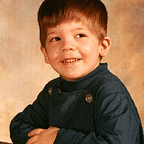Children’s Most Prevalent Health Problem is Caused by a Who, not a What
As a human sexuality professor, I begin my lecture series on sexual abuse by asking my students who they think is most likely to be sexually assaulted. Almost without exception, my students answer to this question is “women.” But this answer is incorrect. Although women are far more likely to be sexually assaulted when compared to men (about six times more likely), they are nowhere as likely to be sexually assaulted as children are. With nearly 70% of all reported sexual assaults (including assaults on adults) occurring to children ages 17 and under, children are by far sexual assaults most likely victims.
In fact, sexual abuse is children’s most prevalent health problem. The American Medical Association reports 10 to 25 percent of children are sexually abused before their 18th birthday and the American Psychological Association reports 1 in 6 boys and 1 in 4 girls are sexually abused before the age of 18 years. To put this in perspective, before the age of 19 years, less than 20 out of every 100,000 children will be diagnosed with some form of cancer, whereas about 20,000 out of every 100,000 children will be victims of some form of sexual abuse.
The causes of childhood sexual abuse are complex, but one thing is clear: Sexual ignorance breeds sexual abuse, and sexual knowledge fights sexual abuse. With this said, let me test your sexual knowledge by having you determine if the following statement is True or False:
T or F: Children are most likely to be sexually abused by strangers.
What is your answer?
This statement is FALSE. Research studies have consistently found children are rarely sexually abused by strangers, instead, children are abused by someone they know, and often, this someone is a family member. For example, in a study by Martine Hébert and her colleagues at the Department of Sexology at the University of Quebec at Montreal, they surveyed a representative sample of 804 adults and found 16% of them had been sexually abused as children. From this sample, between 84% and 90% of them knew their perpetrator; and the perpetrator was a family member in 41% to 48% of the cases.
Now that you are in-the-know about childhood sexual abuse, if you are going to do nothing with this knowledge, then you are allowing this epidemic to continue. Not only is knowledge power, it automates responsibility. Do something, share your new-found sexual knowledge, and be a part of the fight against childhood sexual abuse.
References
American Psychological Association (February 19, 2014). Child Sexual Abuse: What Parents Should Know. http://www.apa.org/pi/families/resources/child-sexual-abuse.aspx
Ashcroft, J., Daniels, D. J., & Hart, S. V. (2003). Youth Victimization: Prevalence and Implications. U.S. Department of Justice, Office of Justice Programs, National Institute of Justice. https://www.ncjrs.gov/pdffiles1/nij/194972.pdf
Dube, S. R., Anda, R. F., Whitfield, C. L., Brown, D. W., Felitti, V. J., Dong, M., & Giles, W. H. (2005). Long-Term Consequences of Childhood Sexual Abuse by Gender of Victim. American Journal of Preventive Medicine, 28, 430–438.
Elliott, M., Browne, K., & Kilcoyne, J. (1995). Child sexual abuse prevention: What offenders tell us. Child Abuse & Neglect, 5, 579–594.
Federal Bureau of Investigation (2012). Victims sex by offense category. https://ucr.fbi.gov/nibrs/2012/table-pdfs/victims-sex-by-offense-category-2012
Finkelhor, D., & Shattuck, A. (2012). Characteristics of crimes against juveniles. Crimes against Children Research Center: Durham, NH. http://www.unh.edu/ccrc/pdf/CV26_Revised%20Characteristics%20of%20Crimes%20against%20Juveniles_5-2-12.pdf
Hébert, M., Tourigny, M., Cyr, M., McDuff, P., & Joly, J. (2009). Prevalence of childhood sexual abuse and timing of disclosure in a representative sample of adults from Quebec. The Canadian Journal of Psychiatry / La Revue canadienne de psychiatrie, 54, 631–636.
National Cancer Institute, Surveillance, Epidemiology, and End Results Program. Table 28.2: Age-Adjusted SEER Cancer Incidence Rates, 1975–2015, By Primary Cancer Site and Year of Diagnosis, All Races, Males and Females. https://seer.cancer.gov/csr/1975_2015/
Richards, K. (April 22, 2018). The causes of paedophilia and child sexual abuse are more complex than the public believes, http://theconversation.com/the-causes-of-paedophilia-and-child-sexual-abuse-are-more-complex-than-the-public-believes-94915
Snyder, H. N. (2000). Sexual Assault of Young Children as Reported to Law Enforcement: Victim, Incident, and Offender Characteristics. A Statistical Report using data from the National Incident-Based Reporting System. https://www.bjs.gov/content/pub/pdf/saycrle.pdf
Townsend, C., & Rheingold, A.A., (2013). Estimating a child sexual abuse prevalence rate for practitioners: Studies. Charleston, S.C., Darkness to Light. Retrieved from www.D2L.org
Wildeman, C., Emanuel, N., Leventhal, J. M., Putnam-Hornstein, E., Waldfogel, J., & Lee, H. (2014). The prevalence of confirmed maltreatment among US children, 2004 to 2011. Journal of the American Medical Association Pediatrics, 168, 706–713.
…
Dr. Don Lucas, Ph.D. is a Professor of Psychology and head of the Psychology Department at Northwest Vista College in San Antonio Texas. He loves psychology, teaching, and research.
If you like this story, then check out Don’s videos on his YouTube channel, 5MIweekly: https://www.youtube.com/channel/UCQFQ0vPPNPS-LYhlbKOzpFw/featured, follow him on Instagram @5MIweekly, like him on Facebook: http://fb.me/5MIWeekly, and check out his website: 5Miweekly.com
